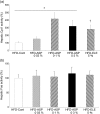Asperuloside stimulates metabolic function in rats across several organs under high-fat diet conditions, acting like the major ingredient of Eucommia leaves with anti-obesity activity
- PMID: 25191539
- PMCID: PMC4153281
- DOI: 10.1017/jns.2012.12
Asperuloside stimulates metabolic function in rats across several organs under high-fat diet conditions, acting like the major ingredient of Eucommia leaves with anti-obesity activity
Abstract
Eucommia leaves (Eucommia ulmoides Oliver) contain chlorogenic acid (a caffeic acid derivative) and geniposidic acid and asperuloside (ASP), iridoid glucosides used in beverages. We used a metabolic syndrome rat model, produced by feeding a 35 % high-fat diet (HFD), to examine potential anti-obesity and anti-metabolic syndrome effects and mechanisms of chronic administration of ASP. These effects were compared with Eucommia leaf extract (ELE), the positive control, which exhibits anti-obesity effects. A total of six rats were studied for 3 months in five groups. ASP suppressed body weight, visceral fat weight, food intake and circulating levels of glucose, insulin and lipids, and increased the plasma adiponectin level in rats on a HFD. These effects are similar to those of ELE, except for the influence on the plasma glucose level. RT-PCR studies showed that ASP (like ELE with known anti-obesity effects) diminished isocitrate dehydrogenase 3α, NADH dehydrogenase flavoprotein 1 (Comp I) mRNA and fatty acid synthase levels (white adipose tissue), increased carnitine palmitoyltransferase 1α and acyl-CoA dehydrogenase, very-long-chain mRNA levels (liver), and increased Glut4, citrate synthase, isocitrate dehydrogenase 3α, succinyl CoA synthase, peroxisomal 3-ketoacyl-CoA thiolase, dihydrolipoamide succinyl transferase and succinate dehydrogenase mRNA levels (skeletal muscle) under HFD conditions. Interestingly, ASP administration resulted in significantly increased mRNA levels of uncoupling protein 1 (UCP1) in the brown adipose tissue of HFD-fed rats; ELE did not affect the expression of UCP1. The increased expression of UCP1 may be negated by many ingredients other than ASP in the ELE. These findings suggest that chronic administration of ASP stimulates anti-obesity and anti-metabolic syndrome activity in HFD-fed rats across several organs, similar to ELE administration; thus, ASP may be an important ingredient of ELE.
Keywords: ASP, asperuloside; BAT, brown adipose tissue; Acadvl, acyl-CoA dehydrogenase, very long chain; Anti-obesity effects; Asperuloside; CHA, chlorogenic acid; Comp I, NADH dehydrogenase flavoprotein 1; Comp IV, cytochrome c oxidase, subunit 4a; Cpt1α, carnitine palmitoyltransferase 1α; Cs, citrate synthase; ELE, Eucommia leaf extract; Eucommia ulmoides Oliver; FA, fatty acid; Fas, fatty acid synthase; GEA, geniposidic acid; HFD, high-fat diet; Idh3α, isocitrate dehydrogenase 3α; Metabolic function; Ogdh, dihydrolipoamide succinyl transferase; Sol. M., soleus muscle; UCP, uncoupling protein; WAT, white adipose tissue.
Figures

Similar articles
-
The Differences of Mechanisms in Antihypertensive and Anti-Obesity Effects of Eucommia Leaf Extract between Rodents and Humans.Molecules. 2023 Feb 18;28(4):1964. doi: 10.3390/molecules28041964. Molecules. 2023. PMID: 36838952 Free PMC article. Review.
-
Preventive effect of Eucommia leaf extract on aortic media hypertrophy in Wistar-Kyoto rats fed a high-fat diet.Hypertens Res. 2017 Jun;40(6):546-551. doi: 10.1038/hr.2016.189. Epub 2017 Jan 19. Hypertens Res. 2017. PMID: 28100919
-
Chronic administration of Eucommia leaf stimulates metabolic function of rats across several organs.Br J Nutr. 2010 Dec;104(12):1868-77. doi: 10.1017/S0007114510002965. Epub 2010 Aug 9. Br J Nutr. 2010. PMID: 20691136
-
Eucommia bark/leaf extract improves HFD-induced lipid metabolism disorders via targeting gut microbiota to activate the Fiaf-LPL gut-liver axis and SCFAs-GPR43 gut-fat axis.Phytomedicine. 2023 Feb;110:154652. doi: 10.1016/j.phymed.2023.154652. Epub 2023 Jan 6. Phytomedicine. 2023. PMID: 36638713
-
Eucommia ulmoides Oliv.: ethnopharmacology, phytochemistry and pharmacology of an important traditional Chinese medicine.J Ethnopharmacol. 2014;151(1):78-92. doi: 10.1016/j.jep.2013.11.023. Epub 2013 Dec 1. J Ethnopharmacol. 2014. PMID: 24296089 Review.
Cited by
-
Cornelian Cherry (Cornus mas L.) Iridoid and Anthocyanin Extract Enhances PPAR-α, PPAR-γ Expression and Reduces I/M Ratio in Aorta, Increases LXR-α Expression and Alters Adipokines and Triglycerides Levels in Cholesterol-Rich Diet Rabbit Model.Nutrients. 2021 Oct 16;13(10):3621. doi: 10.3390/nu13103621. Nutrients. 2021. PMID: 34684622 Free PMC article.
-
Dynamic Changes in Metabolite Accumulation and the Transcriptome during Leaf Growth and Development in Eucommia ulmoides.Int J Mol Sci. 2019 Aug 18;20(16):4030. doi: 10.3390/ijms20164030. Int J Mol Sci. 2019. PMID: 31426587 Free PMC article.
-
The Potential of Anti-Diabetic Rākau Rongoā (Māori Herbal Medicine) to Treat Type 2 Diabetes Mellitus (T2DM) Mate Huka: A Review.Front Pharmacol. 2020 Jun 30;11:935. doi: 10.3389/fphar.2020.00935. eCollection 2020. Front Pharmacol. 2020. PMID: 32694996 Free PMC article. Review.
-
Iridoids are natural glycation inhibitors.Glycoconj J. 2016 Aug;33(4):671-81. doi: 10.1007/s10719-016-9695-x. Epub 2016 Jun 15. Glycoconj J. 2016. PMID: 27306206 Review.
-
The Differences of Mechanisms in Antihypertensive and Anti-Obesity Effects of Eucommia Leaf Extract between Rodents and Humans.Molecules. 2023 Feb 18;28(4):1964. doi: 10.3390/molecules28041964. Molecules. 2023. PMID: 36838952 Free PMC article. Review.
References
-
- Matsuzawa Y (2005) Adiponectin identification, physiology and clinical relevance in metabolic and vascular disease. Atheroscler Suppl 6, 7–14 - PubMed
-
- Fujikawa T, Hirata T, Wada A et al. (2010) Chronic administration of Eucommia leaf stimulates metabolic function of rats across several organs. Br J Nutr 104, 1868–1877 - PubMed
-
- Jiangsu New Medical College (editor) (1997) Chinese Materia Medica Dictionary, p. 1031. Shanghai: Shanghai Science and Technology Publishing House
-
- Nakamura T, Nakazawa Y, Onizuka S, et al. (1997) Studies on the constituents of Eucommia ulmoides iridoids from the leaves. Nat Med 51, 275–277
LinkOut - more resources
Full Text Sources
Other Literature Sources
Research Materials
Miscellaneous

